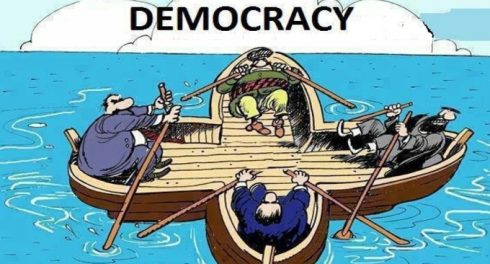|
![]()
Photo: Unsplash
Given our role, TAI has a presumption that collaboration is a good thing, but with a hard eye on the evidence. Research from ODI born of work in Indonesia, Kenya, and the Amazon Basin suggests that collaboration for governance at the nexus of water-energy-food issues is effective. Mary Gray argues for more collaboration between researchers and tech companies although with eyes wide open to the risks.
Talking of tech collaborations – does digital tech truly enable citizen monitoring? Here are 5 World Bank projects trying to offer some answers, while Loren Treisman explains for CNN how Kenyans are using tech to stop election fraud and violence. When it comes to blockchains, Michael Pisa and Matt Juden from the Center for Global Development unpack hype vs. reality. With a skeptical slant, professors at the University of Washington are teaching the next generation how to detect big data BS (can we audit that class?)
But why isn’t the whole anti-corruption research community moving away from diagnosis towards treatment? Are we too obsessed with simply highlighting the problem? Transparency International veteran Mark Pyman suggests researchers are too disconnected from getting to practical tools. Meanwhile, Brian Levy deconstructs the donor corruption discourse and repeats his call to steer away from maximalist commitments he believes inconsistent with the substance and spirit of task at hand – go incremental!
Duncan Green suggests we have the framing all wrong and offers some recommendations to shake up thinking/practice – he concludes that aid should step out of the anti-corruption space and leave it to strengthened local politics. On that front Kelsey Goodman of the CDA Collaborative Learning Projects offers a timely reminder of last year’s evidence review on political corruption.
Want to learn how tax havens work, and how to beat them? Tim Harford offers a refreshingly straight forward introduction to the problems of hidden offshore wealth, while the New York Times asks what happens when the apartment next door is owned by an oligarch. What about philanthropy as a tool for tax dodging? Discover Billionaire Stephen Ross’s method and his ten for one charitable deduction.
This week computer scientists revealed some of the hidden architecture of tax havens – it will help explain why Panama is a good conduit for funds but not an ideal tax haven. To similar ends, data experts are also exploring how to make best use of available country by country reporting data – see the findings of last week’s design sprint under the Open Data for Tax Justice project. This is sparking healthy debate on the merits of focusing on data pipelines and central databases. See Tim Davies’ suggested principles in response that are valuable reading for of us thinking about design of data projects – can we risk more barriers between data and domain experts?
What the chance the private sector might play a more proactive governance role? Interesting to see HSBC calling out of Nobel Plantations for deforestration abuses when other banks failed to step up. How might we encourage the same on other irregularities? What happens when firms, such as Nobel, fail to adhere to standards? Interesting thatChinese authorities are promoting mandatory environmental disclosure as listed companies failed a corporate disclosure test.
HSBC’s step against Nobel Plantations only followed investigative work by the likes of Greenpeace. In another testament to the power of investigative capacity and disclosure, the Panama Papers claimed another head of government this week with Nawaz Sharif’s ouster for corruption. Although, on a more encouraging note co-creation is underway on OGP National Action Plan – read how OGP’s Joe Powell kicked things off.
Protests in Venezuela featured heavily on news cycles this past week. Yet what of smaller scale activism – is there sufficient coverage? It turns out that more people in the US protested in June than any month since January Women’s Marches, but that mobilization is under-reported under-counted, and a significant portion not Trump-related.
How do pigs and buttocks connect to effective mobilization? Find out in Carnegie’s Civic Activism Network review of a new and creative wave of civic engagement in Uganda. What of the activist battle in the digital sphere? Technosociologist Zeynep Tufekci considers how the internet is used to mobilize and repress in Twitter and Tear Gas: The Power and Fragility of Networked Protest.
The Equitable Evaluation group comes together to examine the role evaluation plays in supporting or inhibiting progress towards equity in philanthropy. Read the framing paper to understand some of the common pitfalls funders face in evaluating programming and the group’s proposed vision for the future, funded by Kellogg and Kresge Foundations and the California Endowment.
Evaluation is easier when the grantee is self-aware and consciously tracking its own practice. Mercy Corps presents a nicely packaged approach describing its organizational evolution and experience with adaptation.
How is grantmaking changing? The Stanford Social Innovation Review tackles the question with Time to Reboot Grantmaking making the case for a grantmaking pyramid and how this informs the Ford BUILD program. Meanwhile, Tom Steinberg denounces the tyranny of the one pager – do TAI 2-pagers get us off the hook?
Of potential interest…
- Can women benefit from mining? Yes, if they help set the rules – Alfonsina Penaloza helps explain.
- Why is Poland’s Law and Justice Party trying to rein in judiciary? Promise of access to spoils of power contributed to top-down erosion of liberal democracy.
- 10 Lessons for social change giving
- Who gives what in America? This interactive tool lets you explore how giving varies by geography/demographic.
On the calendar…
- ODI in conversation with Rajiv Shah August 16 (London, live stream available)
- MERL Tech September 7-8 (Washington, DC)
- Data Transparency 2017 Conference, September 26 (Washington DC) – US focus
- 7th Financial Transparency Conference, October 24-25 (Helsinki)
- GPSA Citizen Action for Open, Accountable and Inclusive Institutions, Global Forum, October 31 – November 1, 2017 (Washington, DC)
- Feedback Lab Summit November 2-3 (Washington, DC)
- OGP Summit side-event: Academic Conference on Open Government, November 17-18 (Buenos Aires)
- Open Government Partnership Americas Regional Meeting, November 21-22 (Buenos Aires)
- Open Contracting 2017, November 28-29 (Amsterdam)


